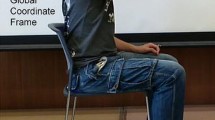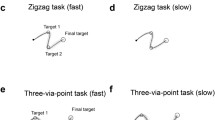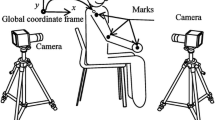Summary
The formation of forearm trajectories of moderate velocities (0.3–1.3 rad/s) was studied in monkeys performing a simple visuomotor task. The experiments were designed to test the hypothesis that the transition from one position to another is subserved by a rapid shift to a final equilibrium of forces in agonist and antagonist muscles. This idea is attractive because it suggests the possibility that in simple movements the trajectory is determined by the inherent inertial and viscoelastic properties of the limb and muscles around a joint. The results indicate that these moderate speed movements are controlled by a gradual, and not a step-like, shift to the final equilibrium position.
Similar content being viewed by others
References
Bizzi E, Polit A, Morasso P (1976) Mechanisms underlying achievement of final head position. J Neurophysiol 39: 435–444.
Brooks VB (1979) Motor programs revisited. In: Talbott RE, Humphrey DR (eds) Posture and movement. Raven Press, New York, pp 13–49.
Coggeshall RE, Ito H (1977) Sensory fibres in ventral roots L7 and S1 in the cat. J Physiol (Lond) 267: 215–235.
Collatos TC, Edgerton VR, Smith JL, Botterman BR (1977) Contractile properties and fiber type compositions of flexors and extensors of elbow joint in cat: Implications for motor control. J Neurophysiol 40: 1292–1300.
Desmedt JE, Godaux E (1978) Ballistic skilled movements: Load compensation and patterning of the motor commands. In: Desmedt JE (ed) Cerebral motor control in man: Long loop mechanisms. Prog Clin Neurophysiol, vol 4. Karger, Basel, pp 21–55.
Feldman AG (1966a) Functional tuning of the nervous system with control of movement or maintenance of a steady posture. II. Controllable parameters of the muscle. Biophysics 11: 565–578.
Feldman AG (1966b) Functional tuning of the nervous system with control of movement or maintenance of a steady posture. III. Mechanographic analysis of the execution by man of the simplest motor tasks. Biophysics 11: 766–775.
Freund H-J, Büdingen HJ (1978) The relationship between speed and amplitude of the fastest voluntary contractions of human arm muscles. Exp Brain Res 31: 1–12.
Ghez C, Vicario D (1978a) The control of rapid limb movement in the cat. I. Response latency. Exp Brain Res 33: 173–189.
Ghez C, Vicario D (1978b) The control of rapid limb movement in the cat. II. Scaling of isometric force adjustments. Exp Brain Res 33: 191–202.
Henneman E (1965) Functional significance of cell size in spinal motoneurons. J Neurophysiol 28: 560–580.
Kato M, Tanji J (1971) Physiological properties of sensory fibers in the spinal ventral roots in the cat. Jpn J Physiol 21: 71–77.
Kelso JAS, Holt KG (1980) Exploring a vibratory systems analysis of human movement production. J Neurophysiol 43: 1183–1196.
Milner-Brown HS, Stein RB, Yemm R (1973) The contractile properties of human motor units during voluntary isometric contractions. J Physiol (Lond) 228: 285–306.
Polit A, Bizzi E (1978) Processes controlling arm movements in monkeys. Science 201: 1235–1237.
Robinson DA (1964) The mechanics of human saccadic eye movement. J Physiol (Lond) 174: 245–264.
Sakitt B (1980) A spring model and equivalent neural network for arm posture control. Biol Cybernetics 37: 227–234.
Tanji J, Kato M (1973) Recruitment of motor units in voluntary contraction of a finger muscle in man. Exp Neurol 40: 759–770.
Taub E, Goldberg IA, Taub P (1975) Deafferentation in monkeys: Pointing at a target without visual feedback. Exp Neurol 46: 178–186.
Author information
Authors and Affiliations
Additional information
This research was supported by National Institute of Neurological Disease and Stroke Research Grant NS09343, National Institute of Arthritis, Metabolism, and Digestive Diseases Grant AM26710, National Aeronautics and Space Administration Grant 22-009-798, and National Eye Institute Grant EY02621
Rights and permissions
About this article
Cite this article
Bizzi, E., Accornero, N., Chapple, W. et al. Arm trajectory formation in monkeys. Exp Brain Res 46, 139–143 (1982). https://doi.org/10.1007/BF00238107
Received:
Accepted:
Published:
Issue Date:
DOI: https://doi.org/10.1007/BF00238107




